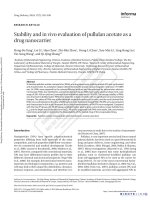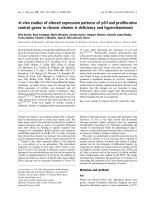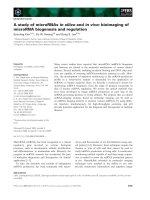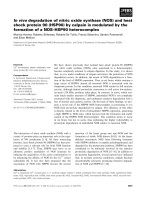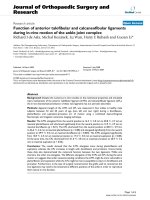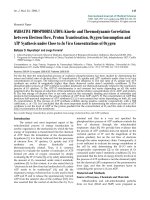In vitro and in vivo assessments of PCL TCP composites for bone tissue engineering
Bạn đang xem bản rút gọn của tài liệu. Xem và tải ngay bản đầy đủ của tài liệu tại đây (1.07 MB, 94 trang )
IN VITRO AND IN VIVO ASSESSMENTS OF PCL-TCP
COMPOSITIES FOR BONE TISSUE ENGINEERING
WONG WAH JIE
(B. Eng. (Hons), NUS)
A THESIS SUBMITTED
FOR THE DEGREE OF MASTER OF ENGINEERING
DEPARTMENT OF MECHANICAL ENGINEERING
NATIONAL UNIVERSITY OF SINGAPORE
2010
INTERNATIONAL JOURNAL PUBLICATIONS
A. Yeo, W. J. Wong, H. H. Khoo and S. H. Teoh “Surface modification of
PCL-TCP scaffolds improve interfacial mechanical interlock and enhance early
bone formation: An in vitro and in vivo characterization” Journal of Biomedical
Materials Research: Part A v. 92A, p. 311-321 (2010)
A. Yeo, W. J. Wong and S. H. Teoh “Surface modification of PCL-TCP
scaffolds in rabbit calvaria defects: Evaluation of scaffold degradation profile,
biomechanical properties and bone healing patterns” Journal of Biomedical
Materials Research: Part A v. 93A, p. 1358-1367 (2010)
i
ACKNOWLEDGEMENTS
The author would like to express his sincere gratitude and heartfelt thanks to
the following individuals who have rendered assistance or gave valuable
advice leading towards the successful accomplishment of this research project:
Professor Teoh Swee Hin (Dept of Mechanical Engineering), project
supervisor, for giving valuable advice and support through the project.
The author appreciates the trust and independence that has been given
to him.
Dr. Alvin Yeo (National Dental Centre), project co-supervisor, for his
constant supervision and guidance in this project. His active role in
coordinating and participating guarantees the success of this study.
Dr. Bina Rai (IMB), project mentor, for giving valuable pointers on the
project throughout the study despite her busy work schedule. The
author would like to thank her for reviewing the drafts.
Dr. Simon Cool (IMB), project mentor, for his suggestions given on the
progress of this project during presentations.
Richard Lin (3M), for his assistance in interferometery of composite
thin films.
Dr Amber Sawyyer and Ivy See Hoo, for their assistance in histology
and histomorphometry work.
ii
Mr Low Chee Wah and Mr Abdul Malik Bin Baba (Impact Mechanics
Lab), for rendering support and assistance on Instron micro tester for
mechanical testing.
Ms Irene Kee (Dept of Experimental Surgery, SGH), for her valuable
assistance and support during animal surgeries and taking care for
them after implantations.
Everyone at VNSC and BIOMAT, for their encouragement and
laughter throughout the whole period, which fills up the entire
durations with wonderful memories.
60 rabbits (R2 to R24) that have been sacrificed in this project till now.
They did not have a choice but it is them that made everything possible.
And last but not least, to ALL those who has contributed in one way or
another in this project.
iii
TABLE OF CONTENTS
INTERNATIONAL JOURNAL PUBLICATIONS.................................................. i
ACKNOWLEDGEMENTS ...................................................................................... ii
TABLE OF CONTENTS ......................................................................................... iv
SUMMARY............................................................................................................. vii
LIST OF TABLES .................................................................................................... ix
LIST OF FIGURES.................................................................................................... x
CHAPTER 1: INTRODUCTION..............................................................................1
1.1
BACKGROUND .........................................................................................1
1.1.1
Current trends in BTE .........................................................................1
1.1.2
Limitations of current treatments for bone defects ..........................2
1.1.3
Strategies in BTE ..................................................................................3
1.2
RESEARCH OBJECTIVES..........................................................................6
1.3
RESEARCH SCOPE ....................................................................................7
CHAPTER 2: LITERATURE REVIEW ....................................................................8
2.1
BONE PHYSIOLOGY .................................................................................8
2.2
BIOMATERIALS.......................................................................................11
2.2.1
Polycaprolactone (PCL) ....................................................................11
2.2.2
Biodegradation ..................................................................................12
2.2.3
Tri-Calcium Phosphate (TCP) ..........................................................14
2.2.4
PCL-TCP scaffolds .............................................................................14
2.2.5
Bone Morphogenetic Proteins (BMP-2) ...........................................17
2.2.6
Heparin...............................................................................................20
CHAPTER 3: EFFECTS OF POROSITIES OF PCL-TCP SCAFFOLDS ON BONE
REGENERATION, SCAFFOLD DEGRADATION AND MECHANICAL
PROPERTIES. ..........................................................................................................23
3.1
INTRODUCTION .....................................................................................23
3.2
MATERIALS AND METHODS...............................................................26
3.2.1
Scaffold Fabrication ...........................................................................26
iv
3.2.2
Porosity Calculation ..........................................................................26
3.2.3
Experimental Design .........................................................................26
3.2.4
Animal husbandry and scaffold implantation ................................27
3.2.5
Micro-CT analysis ..............................................................................29
3.2.6
Mechanical strength testing ..............................................................30
3.2.7
Histological Analysis ........................................................................31
3.2.8
Histomorphometric Analysis ...........................................................31
3.2.9
Mineral Apposition Rate (MAR) ......................................................32
3.2.10
Statistical Analysis .............................................................................33
3.3
RESULTS ...................................................................................................33
3.3.1
Scaffolds characterisations ................................................................33
3.3.2
µ-CT analysis .....................................................................................34
3.3.3
Compressive strength .......................................................................37
3.3.4
Push Out test ......................................................................................38
3.3.5
Histology ............................................................................................39
3.3.6
Histomorphometric Analysis ...........................................................40
3.3.7
Mineral Apposition Rate (MAR) ......................................................41
3.4
DISCUSSIONS ..........................................................................................42
3.5
CONCLUSIONS .......................................................................................49
CHAPTER 4: PRELIMINARY EVALUATION OF PCL-TCP SCAFFOLDS AS
CO-DELIVERY SYSTEMS FOR HEPARIN AND BMP-2 IN VITRO..................51
4.1
INTRODUCTION .....................................................................................51
4.2
MATERIALS AND METHODS...............................................................53
4.2.1
Porcine osteoblasts culture ...............................................................53
4.2.2
Cell culture and BMP-2 treatment ...................................................53
4.2.3
Heparin and BMP-2 treatment .........................................................54
4.2.4
Protein determination .......................................................................54
4.2.5
Alkaline phosphatase activity ..........................................................55
4.2.6
Western blot .......................................................................................55
4.2.7
Alizarin red staining..........................................................................55
v
4.2.8
Release profile studies .......................................................................56
4.2.9
BMP-2 Release....................................................................................56
4.2.10
Statistical Analysis .............................................................................56
4.3
RESULTS ...................................................................................................57
4.3.1
Optimal BMP-2 concentration ..........................................................57
4.3.2
Western blot analysis ........................................................................58
4.3.3
Alizarin red staining..........................................................................59
4.3.4
Optimal heparin concentration ........................................................59
4.3.5
Protein release profile .......................................................................60
4.3.6
BMP-2 release profile ........................................................................61
4.3.7
ALP bioactivity of eluted BMP-2 ......................................................62
4.4
DISCUSSIONS ..........................................................................................62
4.5
CONCLUSIONS .......................................................................................67
CHAPTER 5: FINAL RECOMMENDATIONS ....................................................68
5.1
Effects of porosities of PCL-TCP scaffolds on in vivo bone
regeneration. ....................................................................................................68
5.2
Preliminary in vitro evaluation of PCL-TCP scaffolds as co-delivery
systems for heparin and BMP-2 .........................................................................68
BIBLIOGRAPHY .....................................................................................................70
APPENDIX (PUBLICATIONS) .............................................................................82
vi
SUMMARY
This project consists of two chapters and revolves around PCL—TCP
composite scaffolds.
Pore size and porosity has always been an important property which
affects cell and tissue infiltration. This has direct influence on bone
regeneration and scaffold degradation upon implantation. In this study,
acellular scaffolds of varying pore size and porosity were left in rabbit calvaria
defects and explanted at 2, 4, 8, 12 and 24 weeks. Porosities (Group A: 74.9 ±
1.7%, Group B: 86.7 ± 0.2%) and pore size (Group A: 500 ± 73µm, Group B: 723
± 92µm) were determined through Micro CT. %BV/TV from Micro CT
demonstrated an increase up to 8 week and stabilizes thereafter. Power law
relationship governed scaffold degradation rate regardless of porosity. Group
B scaffolds (6 weeks) reached 50% scaffold loss faster than Group A (10
weeks). Mechanical properties between both groups were comparable
throughout the study. Lastly, histology and histomorphometry detected bone
formation and active vascularisation in all defects. In summary, porosities and
pore size of PCL-TCP scaffolds has negligible effects on bone regeneration and
scaffold degradation.
Chapter 4 focused on the effects of BMP-2 and heparin on pig
osteoblasts. Porcine osteoblasts obtained through explant culture displayed
highest ALP activity in the presence of 100ng/ml of BMP-2 and 300ng/ml of
vii
heparin. Alizarin red staining and western blot confirmed the bioactivity of
BMP-2 used. Protein release from Group D scaffolds has a biphasic release
similar to Group B. This is in agreement with BMP-2 release profile. ALP
activities of various groups were comparable mainly due to low concentration
of eluted BMP-2. In conclusion, heparin and BMP-2 has demonstrated its
potential as co delivery system in this preliminary study. More studies should
be carried out to confirm the hypothesis.
viii
LIST OF TABLES
Table 3.1: Physical parameters of PCL-TCP scaffolds
ix
LIST OF FIGURES
Figure 2.1:
Diagram showing skeletal long bone structure which comprises
of cortical and trabecular bone (Biomedical Tissue Research
Group, 1996)
Figure 2.2
Schematic diagram showing stages of bone remodelling process
(Biomedical Tissue Research Group, 2007)
Figure 2.3:
Chemical Structure of PCL polymer (Wikipedia, 2006)
Figure 2.4
Chemical structure of tricalcium phosphate (CambridgeSoft
Corporation, 2004)
Figure 2.5:
Activation of SMAD proteins after BMP mediation (Sakou, 1998)
Figure 2.6:
Chemical structure of Heparin (Gray et al., 2008)
Figure 3.1:
Micro CT images of scaffolds before implantation (A) Group A
(B) Group B
Figure 3.2:
Implantation of scaffolds into rabbit calvarial defects
Figure 3.3:
Calculation of interlabel distances using Bioquant Image
Analysis® software
Figure 3.4:
Representative µ-CT images of explants specimens with PCLTCP scaffold of (A) 75% porosity (B) 85% porosity (blue: scaffold,
yellow: new bone growth and beige: calvaria bone)
Figure 3.5:
Percentage BV/TV in PCL-TCP scaffolds by µ-CT with varying
porosities from 2 to 24 weeks of implantation.
Figure 3.6:
Scaffold volumes with varying porosities over a time period of 24
weeks.
Figure 3.7:
Percentage of PCL-TCP scaffolds volume loss with varying
porosities from 2 to 24 weeks of implantation
Figure 3.8:
Compressive strength of PCL-TCP scaffolds with varying
porosities from 2 to 24 weeks of implantation (* denotes p < 0.05)
Figure 3.9:
Shear strength of PCL-TCP scaffolds with varying porosities
from 2 to 24 weeks of implantation (* denotes p < 0.05)
x
Figure 3.10: Representative images of ex vivo specimens at (A) 4 weeks (B) 8
weeks stained for Goldner’s Trichome (green sections:
mineralised bone; areas labelled ‘S’ denote PCL-TCP scaffolds)
Figure 3.11: Percentage BV/TV of PCL-TCP scaffolds by histomorphometry
with varying porosities from 8 to 24 weeks of implantation
Figure 3.12: Representative image showing diffused flurochrome labels
between 2 and 8 weeks (red label – alizarin, green label – calcein)
Figure 3.13: Mineral Apposition Rate (MAR) of PCL-TCP scaffolds with
varying porosities from 8 to 24 weeks of implantation
Figure 4.1:
Alkaline phosphatase activity per mg protein of cells at different
BMP-2 concentrations (* denotes p < 0.05)
Figure 4.2:
Western blot for pig osteoblasts treated with 100ng/ml BMP-2 at
different treatment times. (top - phosphorylated SMAD 1/5/8 and
bottom – Total SMAD 1/5/8)
Figure 4.3:
Alizarin red staining for pig osteoblasts with and without BMP-2
(control) treatment for 3 weeks.
Figure 4.4:
Alkaline phosphatase activity per unit protein of cells at different
BMP-2 and/or heparin concentrations (* denotes p < 0.05)
Figure 4.5:
Amount of total protein release at various time points (Group A:
PCL-TCP scaffolds loaded with PBS. Group B: PCL-TCP
scaffolds loaded with 100ng/ml BMP-2. Group C: PCL-TCP
scaffolds loaded with 300ng/ml of heparin. Group D: PCL-TCP
scaffolds loaded with 300ng/ml of heparin and 100ng/ml of BMP2)
Figure 4.6:
Amount of BMP-2 release at various time points. (Group B: PCLTCP scaffolds loaded with 100ng/ml BMP-2. Group D: PCL-TCP
scaffolds loaded with 300ng/ml of heparin and 100ng/ml of BMP2) Group A and C showed no release of BMP-2 at all time points.
Figure 4.7:
Bioactivity of eluted BMP-2 at different time points (Group A:
PCL-TCP scaffolds loaded with PBS. Group B: PCL-TCP
scaffolds loaded with 100ng/ml BMP-2. Group C: PCL-TCP
scaffolds loaded with 300ng/ml of heparin. Group D: PCL-TCP
scaffolds loaded with 300ng/ml of heparin and 100ng/ml of BMP2)
xi
CHAPTER 1: INTRODUCTION
1.1
BACKGROUND
This chapter aims to give the reader an overview of the current trends in
bone tissue engineering (BTE). Following that, limitations of available
treatments for bone defects and various strategies of BTE will be discussed.
1.1.1
Current trends in BTE
Healthcare spending in US can be represented by National Health
Expenditure (NHE). It is defined as the “total amount spent to purchase
healthcare goods and services as well as investment in the medical sector to
produce healthcare services”(NHED, 2006). NHE has been rising rapidly
throughout the years from $153 billion in 1976 to $1990 billion in 2006 (NHED,
2006). Healthcare comprises of 16% of GDP in 2006 and is expected to increase
to 19% in a decade. Average annual growth of healthcare expenses involving
musculoskeletal conditions is ranked second at 8.5% (HCUP, 2006). The huge
growth can be attributed to the rapidly aging population. Also, more highimpact accidents have led to an increase in serious limb trauma. Bone and Joint
decade (2000-2010) was set up by United Nations and World Health
Organisation to raise awareness of the growing costs and also to deepen
understanding of musculoskeletal diseases through research (BJD, 2000-2010).
1
In Singapore, Government Health Expenditure/Total Government Expenditure
increased from 6.5 to 7.1% between 2006 to 2008 (MOH, 2008).
1.1.2
Limitations of current treatments for bone defects
For surgical procedures involving bone grafts, patients usually suffer
from trauma-related injuries or bone fractures. Currently, the gold standard
for bone grafts is autologous bone commonly taken from iliac crest.
Autologous bone are bones extracted from another part of patient’s own body
(Casey K C, 2006). The drawbacks include an additional surgery site for
harvesting and limited availability (Enneking et al., 1980). Other types of bone
grafts include tissues taken from human donors (allografts) or xenografts
obtained from animals. Allografts are not as popular due to the increased risk
of disease transmission, high cost, graft rejection (Gitelis and Saiz, 2002), and
the acceptance of xenografts in certain races or religion may be highly
controversial due to its animal origin. Allografts which have undergone
chemical treatment to remove minerals are known as demineralised bone
matrix. Collagen and other growth factors are still being retained but they
have low mechanical strength due to loss of minerals. Even though it is widely
used as bone substitute, its effectiveness fluctuates in different patients
(Drosos et al., 2007; Kay, 2007). Large clinical defects resulting from bone
cancer or trauma are currently treated with titanium plates. This may lead to
2
complications like rejection and stress shielding. In serious cases, revision
surgery has to be conducted to replace the implant. oLimitations to current
bone grafts as discussed propel researchers to look into the field of bone tissue
engineering for an ideal bone substitute.
1.1.3
Strategies in BTE
Tissue engineering is the restoration, improvement, maintenance and
substitution of damaged tissues and organs using principles of biology and
engineering (Langer and Vacanti, 1993). BTE consists of an interplay of
scaffold technology, growth factors and cells. In this thesis, the focus will be on
using composite scaffold technology in enhancing bone regeneration through
in vitro and in vivo studies.
Scaffold intended for BTE should possess the following properties:
1. High porosity and pore interconnectivity to allow cell growth,
migration and promote vascularisation (Sundelacruz and Kaplan, 2009).
2. Biocompatible, bioresorbable and controllable degradation rate to
match surrounding tissue growth.
3. Suitable surface topography whereby cells are able to attach, proliferate
and differentiate (Stevens et al., 2008).
3
4. Mechanical properties that closely resemble the defect site and has the
strength to withstand load upon implantation (Hutmacher D.W, 2001).
5. The ability to impregnate cells, growth factors and drugs which can
trigger surrounding cells for bone regeneration; controlled drug or
growth factor delivery can also be effectively targeted at the defect site.
6. Ease of manufacturing is necessary for the scaffold to be mass
produced.
7. Customizability of the shape and size of scaffold will be favourable for
use in different clinical applications (Jones, 2005).
It must be noted that interdependent relationships exist among the desired
properties discussed above. One example is when the porosity of scaffold is
increased, cells are able to infiltrate easily but mechanical strength will
decrease. Scaffold degradation time will also shorten due to lower scaffold
volume. This particular scaffold may be suitable for non load bearing
anatomical sites but not for the reverse.
In this study, PCL-TCP composites were selected as the delivery
vehicle. Hydrophobic nature of PCL is improved by adding bioactive TCP
particles. Mechanical strength of composite is increased as TCP scaffolds are
originally brittle. Furthermore, PCL-TCP composites have shown to be
biocompatible, controlled degradation rate and effective delivery systems for
growth factors (Rai et al., 2005b; Yeo et al., 2008a).
4
Growth factors are “secreted by a wide range of cell types to transmit
signals that activate specific developmental programs controlling cell
migration, differentiation and proliferation” (Chen and Mooney, 2003). They
transmit signals by attaching onto receptors on the cell surface. Signals will
then be passed through the cell membrane and results in the expression of a
target gene. This process is extremely complex and may involve multiple
growth factors and receptors for one particular signal (Johnson et al., 1988;
Pimentel, 1994). Some of the highly researched osteoinductive growth factors
include Bone morphogenetic proteins (BMP-2), Transforming growth factor-β
(TGF-β), Fibroblast growth factor (FGF), Insulin-like growth factor (IGF) and
Platelet-derived growth factor (PDGF). BMP-2 is arguably the most potent
osteoinductive growth factor and will be elaborated on in the next chapter
(Bessa et al., 2008b). FGF stimulates neo-angiogenesis, indirectly augmenting
bone regeneration by providing necessary nutrients to the core of defect site
(Hurley et al., 1993; Rifkin and Moscatelli, 1989). IGF enhances the proliferation
of osteoblasts ,osteoclasts and mineralisation (Khan et al., 2000). PDGF exhibits
stimulatory effects on osteoblasts proliferation (Canalis et al., 1989) especially
in bone fracture healing (Andrew et al., 1995).
Drug delivery system (DDS) is a “technology that enables biological
signalling molecules to enhance in vivo therapeutic efficacy by combination
with biomaterials”(Tabata, 2005). Growth factors cannot be applied to the
5
defect site in solution because they will immediately diffuse away from the
defect site. In addition, direct injection of growth factors at high doses has been
shown to generate undesirable results (Yancopoulos et al., 2000). Negative
feedback at high levels has been shown to induce heterotopic bone formation
(Paramore et al., 1999) and even resulted in formation of antibodies in clinical
trials (Walker and Wright, 2002). Here, a carrier is needed to ensure sustained
delivery of a growth factor at the defect site. The release profile of the growth
factor from the vehicle shall usually be gradual and controllable spatially and
temporally to ensure maximum therapeutic effects (Chen and Mooney, 2003).
1.2
RESEARCH OBJECTIVES
The general aim in this thesis was to evaluate and improve on the current
properties of PCL-TCP composites from various aspects namely porosity and
cell modulators in both in vitro and in vivo environments.
The two specific aims of this research was
1. To investigate the effects of bone regeneration, scaffold degradation and
mechanical properties of PCL-TCP scaffolds with different porosities in
vivo.
2. To evaluate the effects of heparin on BMP-2 release and bioactivity from
PCL-TCP scaffolds in vitro.
6
1.3
RESEARCH SCOPE
In the first chapter, two different groups of scaffolds were randomly placed in
rabbit calvaria defects and sacrificed after 2, 4, 8, 12 and 24 weeks. [Group A:
~75% porosity, Group B: ~82% porosity]. Upon sacrifice, at each interval, the
specimens
were
subjected
to
µ-CT
analysis,
mechanical
test
and
histomorphometric analysis. This will enable us to determine the effects of
porosity differences on bone regeneration, scaffold degradation and
mechanical integrity.
The final chapter firstly examined the effectiveness of BMP-2 and heparin
on pig osteoblasts in enhancing osteoblast differentiation. Pig osteoblasts was
chosen to simulate implantation conditions which is in line with our future
plan to assess the co-delivery system in a porcine model. Optimal
concentration of both BMP-2 and heparin was then determined and adapted
for subsequent analysis. Release profile of BMP-2 from PCL-TCP scaffolds was
plotted for signs of sustained delivery when immersed in PBS solution.
Heparin was chosen to improve binding and regulate release of BMP-2 here
and concurrently act as a framework for binding of endogenous growth factors
upon implantation.
7
CHAPTER 2: LITERATURE REVIEW
2.1
BONE PHYSIOLOGY
In order to regenerate bone using BTE techniques, the understanding of the
structure and cells which participate in bone repair is of utmost importance.
Bone is composed of around 70-90% of minerals with the rest in the form of
proteins. Within the proteins in bone, the ratio of collagenous to noncollagenous stands at 9:1. This is in stark contrast with other tissues consisting
of only 10% collagenous proteins (Gokhale et al., 2001). High strength and
rigidity of the bone stem is attributed to its mineral component, which is
similar to hydroxyapatite (Ca 10 (PO 4 )(OH) 2 ). Bone has an elastic nature and it is
also resistant to tension due to the high amount of collagen fibres.
In Figure 2.1, there are two layers of bone namely: cortical (compact) and
trabecular (spongy) bone. Cortical bone surrounds the outer layer of bone with
thick and compact walls. It houses the medullary cavity where bone marrow
resides during life. Trabecular bone, which has a spongy honeycomb structure,
is only located at the epiphysis ends of long bone. Haematopoietic bone
marrow also resides within the pores of trabecular network. With the
exception of the articulating surfaces, the cortical bone is surrounded by the
periosteum which is a thin layer of connective tissue made of a collagen rich
layer and osteoprogenitor cells.
8
Figure 2.3: Diagram showing skeletal long bone structure which comprises of
cortical and trabecular bone (Biomedical Tissue Research Group, 1996)
There are a wide variety of cells that participate in the bone remodelling
and regeneration process (Figure 2.2).
The main duty of osteoclasts is to
remove and resorb bone. When osteoclasts determine a bone site to be
resorbed, it will create a barrier on its surface using its apical membrane. The
pH level beneath osteoclast will be decreased, which triggers the formation of
hydrogen ions and lysomal enzymes. After the resorption phase, Howship’s
lacuna, which is a depression with ruffled border, is created (Raisz and
Seeman, 2001).
9
Figure 2.4: Schematic diagram showing stages of bone remodelling process
(Biomedical Tissue Research Group, 2007)
In the renewal phase, macrophages are present at resorbed site.
Osteoblasts, which had the ability to synthesis new bone, will continue to
mineralise. During this process, it maintains and develops various channels
with surrounding cells to facilitate various cellular actions through receptors
and transmembrane proteins. When osteoblasts have completed the bone
formation process, it will experience multiple transformations. It can convert
itself into bone lining cells, which cover bone surfaces after quinesence phase.
Some osteoblasts may be programmed to die after fulfilling its duties. The rest
will become osteocytes and reside in bone matrix. Osteocytes are classified as
mature osteoblasts and will not mineralise any further (Lian J 1999).
10
2.2
BIOMATERIALS
2.2.1
Polycaprolactone (PCL)
Poly(ε-caprolactone) (PCL) is a semi crystalline resorbable polyester.
PCL belong to aliphatic polyester family and thus share similar properties
with other members such as polyglycolide (PGA) and polylactide (PLA). It has
a low melting point of between 59 to 64°C, depending on its level of
crystallinity. Low melting temperature enhances its processibility. It has a low
glass transition temperature of around -60°C which explains its ductile and
rubbery state at room temperature (Juan Pena, 2006).
PCL has a higher decomposition temperature (350°C) relative to other
aliphatic polyesters which will decompose between 235°C and 255°C. PCL also
possess favorable mechanical properties: Elastic modulus between 300 to
400MPa which matches the stiffness of cancellous bone (100 – 300MPa) and a
tensile strength which ranges from 15 to 60MPa (Zein I, 2002).
Figure 2.3: Chemical Structure of PCL polymer (Wikipedia, 2006)
Each monomer of PCL consists of five methylene groups and one ester group.
PCL is hydrophobic due to the presence of non polar methylene groups
11
(Figure 2.3). Aliphatic ester linkage in PCL makes it susceptible to hydrolytic
degradation.
Low glass transition temperature contributes to the high permeability of
PCL. It is this property that allows PCL to form copolymer blends with other
polymers. PCL is widely used in its copolymer state in controlled release drug
delivery applications (James M Pachence, 2000). PCL is an FDA approved
material used widely in biomedical applications eg in sutures (Rezwan K,
2006).
2.2.2
Biodegradation
The degradation mechanism of polymers used for bone tissue
regeneration must be elucidated thoroughly before the product can be released
into the market. The degradation profile of the scaffold will have a significant
effect on the mechanical properties and various cellular activities that include
host tissue response (Y. Lei, 2007). If the scaffold degrades well before
sufficient bone regeneration take place, implant failure may result. Conversely,
if the scaffold fails to degrade fast enough, it will act as a barrier and hinder
new bone formation. PCL degrades completely in vitro and vivo to release
harmless by-products. This is one advantage that PCL possess which make it
highly suitable for use in medical devices. Unlike PCL, PLGA degrades upon
implantation to form acidic byproducts which is toxic to the body and will
affect cell growth and proliferation directly (Hak-Joon Sung, 2004).
12
The process of polymer degradation at different pH has been
scrutinized by Burkersrodaa et al. The study concluded that polymer can
either break down by surface erosion or bulk degradation. The mechanism of
degradation is dependent on three factors: 1. size of matrix, 2. water diffusivity
into scaffold centre, 3. rate of degradation of polymer reactive groups
(A.S.Htay, 2004; Friederike von Burkersrodaa, 2002). PCL follows a two step
degradation process when it is placed in an in vivo environment. The first step
is a non-enzymatic, random hydrolytic ester cleavage which is triggered
automatically by carboxyl end groups of the polymer chain. Chemical
structure and molecular weight of polymer will affect the duration of the first
step of degradation. When the molecular weight of polymer decreases to about
5000, second step of degradation will commence. The rate of chain scission and
weight of polymer decreases as a result of the formation and removal of short
chains of oligomers from the scaffold matrix. Fragmentation of polymer
precedes the absorption and digestion of polymer particles by phagocytes or
enzymes (C.G Pitt, 1981; Vert, 2002).
13
